TEST BANK
b
,Exam
Name
MULTIPLE CHOICE. Choose the one alternative that best completes the statement or answers the question.
1) A section that divides the body on the longitudinal plane into equal right and left parts is called: 1)
A) median (midsagittal)
B) oblique
C) transverse
D) frontal
E) coronal
2) Which of the following is the correct sequence, going from simplest to most complex, in the 2)
levels of structural organization of the human body:
A) chemical level, tissue level, cellular level, organ system level, organ level, organismal level
B) cellular level, chemical level, tissue level, organ system level, organismal level, organ level
C) chemical level, cellular level, tissue level, organ level, organ system level, organismal level
D) cellular level, chemical level, tissue level, organ level, organ system level, organismal level
E) cellular level, tissue level, chemical level, organ level, organ system level, organismal level
3) Which of these regions are associated with the parts of the arm: 3)
A) femoral, popliteal, patellar
B) brachial, antecubital, carpal
C) nasal, oral, occipital
D) pelvic, pubic, inguinal
E) acromial, sacral, gluteal
4) The muscular system consists of the: 4)
A) muscles in the walls of hollow organs
B) muscles of the heart and those in the walls of the hollow organs
C) skeletal muscles
D) skeletal muscles and the muscles of the heart
E) muscles of the heart
5) The lymphatic system: 5)
A) synthesizes vitamin D
B) responds to internal and external changes by activating appropriate muscles and glands
C) secretes hormones that regulate processes such as growth, reproduction, and nutrient use
(metabolism) by body cells
D) picks up fluid leaked from blood vessels and returns it to the blood
E) produces heat
6) Which system covers the external surface of the body and manufactures vitamin D: 6)
A) endocrine system
B) skeletal system
C) nervous system
D) integumentary system
E) lymphatic system
7) Which of these regions are NOT associated with the ventral (anterior) portion of the head: 7)
A) oral B) orbital C) buccal D) nasal E) occiptal
8) Which of the following systems is matched most accurately to the life function it provides: 8)
, A) respiratory system - digestion
B) nervous system - excretion
C) muscular system - maintaining boundaries
D) integumentary system - movement
E) nervous system - responsiveness
9) Which of the following elements of a control system detects a change: 9)
A) receptor
B) control center
C) effector
D) stimulus
E) efferent pathway
10) Which of the following statements is correct regarding the location of the spleen and stomach: 10)
A) both of these organs are located medially
B) both of these organs are located in the left upper quadrant
C) the spleen is located in the left upper quadrant and the stomach is located in the right
upper quadrant
D) both of these organs are located in the right upper quadrant
E) the spleen is located in the right upper quadrant and the stomach is located in the left
upper quadrant
11) Which of these is NOT a survival need: 11)
A) oxygen
B) water
C) reproduction
D) body temperature
E) nutrients
12) Which of the following is the correct order of elements in a control system: 12)
A) receptor, stimulus, afferent pathway, control center, efferent pathway, effector, response
B) stimulus, receptor, efferent pathway, control center, afferent pathway, effector, response
C) receptor, stimulus, efferent pathway, control center, afferent pathway, effector, response
D) stimulus, receptor, afferent pathway, control center, efferent pathway, effector, response
E) effector, stimulus, efferent pathway, control center, afferent pathway, receptor, response
13) Which of the following activities does not represent an anatomical study: 13)
A) viewing muscle tissue through a microscope
B) studying how the nerves conduct electrical impulses
C) observing the parts of a reproducing cell
D) examining the surface of a bone
E) making a section through the heart to observe its interior
14) The dorsal body cavity houses the: 14)
A) heart and lungs
B) spinal cord and brain
C) tongue
D) urinary and reproductive organs
E) digestive and reproductive organs
15) The stomach, liver, intestines, bladder, rectum, and reproductive organs are housed in the: 15)
A) abdominopelvic cavity
, B) dorsal cavity
C) spinal cavity
D) cranial cavity
E) thoracic cavity
16) Which of the following is NOT a necessary life function: 16)
A) nutrients
B) maintaining boundaries
C) movement
D) responsiveness
E) metabolism
17) The study of the function of the body and body parts is called: 17)
A) homeostasis
B) anatomy
C) physiology
D) irritability
E) negative feedback
18) Which of these regions in the abdominopelvic cavity are medial: 18)
A) epigastric, umbilical, and hypogastric regions
B) umbilical, right lumbar, and left lumbar regions
C) epigastric, right, and left hypochondriac regions
D) iliac (inguinal), lumbar, and hypogastric regions
E) right and left iliac (inguinal), and hypogastric regions
19) The region that contains the navel is the: 19)
A) umbilical region
B) orbital region
C) carpal region
D) anterior knee
E) inguinal region
20) The gluteal region is the: 20)
A) posterior knee area
B) posterior surface of the head
C) shoulder blade region
D) buttock
E) curve of the shoulder
21) Which of the following orientation terms have opposite meanings (in humans): 21)
A) medial and anterior
B) superficial and proximal
C) posterior and intermediate
D) distal and proximal
E) medial and distal
22) Your body thermostat is located in a part of the brain called the hypothalamus. Which of the 22) b
following elements of a control system does this area in the brain represent:
A) stimulus
B) afferent pathway
C) efferent pathway




